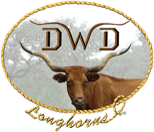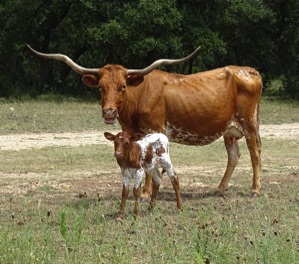
What distinguishes Texas Longhorns from other cattle breeds?
Descended from Andalusian cattle brought to the New World by Spanish explorers in the late fifteenth and early sixteenth centuries, the Texas Longhorn evolved by natural selection from feral Spanish stock without interference of man for almost 400 years. The breed is uniquely adapted to the arid, inhospitable southwestern United States. These thrifty cattle can travel greater distances between watering sites and grazing forage and browse plants underutilized by other breeds. Texas Longhorns are excellent mothers that calve unassisted and possess hearty, disease-resistance.
Texas Longhorns thrive in harsh conditions
Texas Longhorn cattle are small to medium-framed beef animals that mature early and have no difficulty calving. They thrive in harsh conditions that would ruin or kill most other breeds, exhibit remarkable resistance to disease, parasites, heat and cold, and commonly live and reproduce up to 20 years of age. These highly adaptable and ecologically friendly beef cattle are intelligent, gentle, easy to handle, and require far less feed and maintenance than other breeds. Longhorn cows are fearsome protectors of their young, ensuring their survival even in remote, predator-infested wilderness.
Cattle trails add colorful note to history
The history of the Longhorn beef cattle breed fostered many legends. However, the economic importance of these cattle to this country, especially during the two decades following the Civil War when an estimated 10 million fed a hungry nation and restored the devastated Texas economy, is no legend. Texas Longhorn cattle were driven north on several cattle trails where they became the seed stock for the cattle industry throughout the Great Plains and beyond.
Texas Longhorns offer modern day economic bonus
The very traits that facilitated survival of the Texas Longhorns in the wild are of economic importance to beef cattle producers today. Commercial cattlemen utilize Longhorn bulls to breed their first calf heifers, ensuring small, trouble-free calves. As farm and ranch land becomes scarcer and more valuable, much of the remaining productive land will be developed, leaving only marginal country to cultivate our nation's food supply; exactly where the hearty traits of Texas Longhorns are most appreciated.
